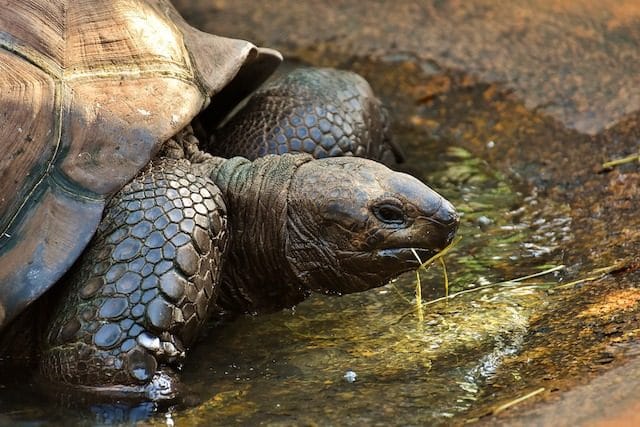If you ever saw the Highlander movies, you may have asked yourself, who wants to live forever? Immortality isn’t all it’s cracked up to be, at least if fiction is to be believed. Dracula, the Q Continuum, no one who has been around for eternity seems happy about it when we meet them in stories. But can we make it a reality? Could anything experience that reality?
Turns out that immortality may not be as fictitious as it sounds, at least not for everything. Researchers studying ginkgo trees that can potentially live thousands of years have discovered that the oldest trees are just as healthy as the youngest ones. Could they live forever? Well, we’d have to wait forever to find out. Still, it’s an encouraging thought that time does not take these things down. Let’s pull back the veil of mortality and see what we can find.
Human Lifespan

It has been suggested that humans may actually have an absolute limit to their lifespan. Right now, the average human lifespan is about 72 years. In 1800, it was only 35 years, but you need to remember why that is. It didn’t mean people were dying at the age of 35 because they were old; it meant a lot of people were dying as children, which drastically lowered the average. People could still live to their 70s and older. But, according to at least some research, the most we may ever be able to get out of a human body is 150 years.
Jeanne Louise Calment is the oldest confirmed person to have ever lived. She passed away at the age of 122 back in 1997.
The belief is that, somewhere between 120 and 150 years, a human body would simply be unable to recover from various stresses and injuries. No matter how healthy you were, it simply wouldn’t work. Like a banana that was on the counter too long, you’re just past your prime.
The study looked at some simple blood tests and measured a ratio of white blood cells as well as the size of red blood cells over a period of time. Based on the data collected and some computer modeling of how changes would continue over time, they determined 150 years was the upper limit for a human body before it could no longer keep up with the stresses of living. They call it senescence, the state of a gradual decay from which there is no coming back.
This in no way means humans are willing to take this sitting down. The quest for immortality has fascinated humans for centuries. Ponce de Leon went looking for the Fountain of Youth in Florida in 1513 with no idea it would one day be a haven for senior citizens. Historians have claimed to have found the Holy Grail more than once over the years, though so far no one has reported immortality after drinking from it.
In modern times, more scientific methods of attaining eternal life have been pursued. We’ll look more into what humans can expect in the future later, but for now, let’s look at the animal kingdom.
The Longest Lived

Many animals can live for quite a while compared to humans, but don’t qualify as immortal by any means. Tortoises, for instance, have made it up to 192 years old so far, which is quite a feat. That’s just a drop in the bucket compared to some, however.
In the ocean, many creatures enjoy a long lifespan. It’s believed that 100-ton Arctic-based bowhead whales can cross the 200-year mark. Their cold water neighbors, the Greenland Shark, can live for 250 years, with some estimates suggesting these animals can reach over 500 years old.
The oldest animal in the world was a quahog clam named Ming. Like a tree, these clams have rings that can be counted to show their age as the shell grows. The shell rings were precisely counted, and the final number was a remarkable 507.
For any animal, hitting 500 years old is incredible, but there are still lifeforms that can do better. Black coral, for instance, has the stamina to last thousands of years. Some off the coast of Hawaii was radiocarbon dated to 4,265 years. That coral was around for the construction of Stonehenge.
More impressive even than that coral was a species of glass sponge discovered in the East China Sea. Researchers determined this particular sponge was as much as 11,000 years old. But still, you’d never call that immortal. That’s just very long-lived. What does it take to cross that line and really become immortal? From what we have observed in the world, a couple of species may have actually done it.
The Immortal Jellyfish
Turritopsis dohrnii is the name of a jellyfish that you can find all over the world. They enjoy temperate waters and range from the Caribbean to Japan. Most people know them by the more common name of immortal jellyfish.
The typical life cycle of a jellyfish works like this. They start as a fertilized egg or gametes. This grows into a larval jellyfish called a planula. The planula sticks to a rock somewhere and turns into weird, hungry little polyps with many little feet and shared feeding tubes. Exciting! The polyps then grow into small jellyfish called an ephyra and finally a fully grown jellyfish called a medusa. So far, so good.
Normally, when a jellyfish gets too old, it dies like anything else. But when the immortal jellyfish finds itself in a position where its life may be threatened by environmental stresses and things aren’t going well, it can revert back to that gamete stage and then start its life all over again.
Obviously, the immortal jellyfish is susceptible to harm like anything else. It could get caught in the propeller of a ship, it could get eaten by a predator, or it could get poisoned by toxins. There are all kinds of ways it could die. But if it never underwent those kinds of traumatic events, if it was left to its own devices, it could potentially live forever.
The Hydra
Closely related to jellyfish, Hydra are freshwater invertebrates. Unlike most creatures, hydra’s stem cells are constantly being renewed. Because these cells are always renewing, the hydra effectively doesn’t age at all. Like the immortal jellyfish, if a hydra can avoid predators or some kind of trauma that would kill it outright, there’s no reason to believe it couldn’t exist in this state forever.
If a hydra does experience trauma, like the loss of a limb, it’s able to regenerate that. More impressively, you can dismember the entire animal, and each piece will regrow into a new hydra. Still not impressed? You can put a hydra in a blender and turn it into a liquid. The cells that you have mulched up will reorganize and grow back into a hydra. Now that’s resilience. Also, an example of a scientist who went a little overboard in his research.
Planarian Worms
You can find planarian worms all over the world. Some live in saltwater, some in fresh, and some on land. Like the hydra, they have an uncanny ability to regenerate their cells. Unlike humans, whose cells slow down over time as they divide and, basically, age, this is not an issue with the worms. Their stem cells show no signs of aging and can keep dividing, keep healing injuries, and keep replacing old cells as if they were brand new.
While human chromosomes end in something called a telomere, a sort of protective cap on the chromosome that follows them as cells divide but gets shorter each time until the cell can no longer divide, planarian worms don’t have this issue. Their telomeres don’t fail over time.
The regenerative ability of a planarian worm is quite impressive. In lab conditions, a segment of a worm that is 1/200th of the original worm is able to regrow an entirely new organism. If their head is split, they can grow two new heads.
Obviously, humans can’t regenerate the same way that any of these creatures can. But that doesn’t mean there aren’t people out there trying their damnedest to turn back the clock or stop it altogether.
Bryan Johnson
No one is at the forefront of trying to live forever quite like millionaire Bryan Johnson. A minor celebrity of social media, not always for the reasons he hopes, Johnson gets in the news every so often when people discover something else about his life-extending efforts. Generally speaking, these are extremely unusual lengths that he goes to, such as getting transfusions of plasma from his own 18-year-old son and also his father to see if it had any effect (it didn’t). He called them his “blood boys.”
Frequently and inexplicably pictured nude on social media, Johnson is often mocked for his suggestion that he has reversed his biological age by people pointing out he looks his age still. He once had donor fat injected into his face and shared pictures online that looked decidedly off-putting. He spends $2 million a year on supplements, experimental procedures, a special diet, and therapies to help him live forever.
According to Johnson, 47, doctors have told him he has the lungs of an 18-year-old and the heart of a 37-year-old. He has the thyroid of a 23-year-old, the prostate of a 30-year-old, and the skin of a 28-year-old. These are all figures that have been publicly reported, anyway.
He attains these goals through an extremely in-depth program he calls Project Blueprint. He has to take over 100 supplements per day to maintain this. Fifteen percent of his daily diet is olive oil, which costs $75 for 2 bottles.
Of course, whether or not any of what he does works won’t pay off in any real way for the rest of us. If he dies young, then he’s dead, and it’s not like anyone can critique him after that. And if it works, the rest of us will be dead and never know, anyway.
How Old Can Humans Get?

We said earlier that humans will probably max out between 120 and 150 years of age. That’s also just one opinion on the matter. Others have suggested we could live as long as a thousand years if we started to play with our genetic code a little bit.
In much the same way that we’ve been studying how creatures like the hydra can seemingly live forever, it comes down to the genes that they have. If we can activate the same genes in humans, or introduce them, perhaps we could enjoy the same results. If we get good enough at it, maybe we can go well beyond a thousand years. The number 20,000 years was suggested by a professor of molecular biogerontology at the Institute of Inflammation and Ageing at the University of Birmingham.
Other scientists have criticized the methodology of those who have set hard limits on human lifespan. Some say there’s no reason at all to suspect that we need to have a limit. That doesn’t mean they’re suggesting humans are effectively immortal in any way. What they’re saying is that when you assign a hard number to it, you are probably overstepping your bounds, scientifically speaking.
That approach does hold up to scrutiny when you think about it. If most people only live to be between 70 and 80, and then you see someone who lives to be 120, it does make you think that there’s more going on than you realize. If someone can live to 120, could they arguably live to 130? It doesn’t make sense to pick an arbitrary number and say that’s how long people will live.
As it stands right now, we are pretty far from immortal. But that doesn’t mean there’s no hope for the future. If a little worm, a jellyfish, and a hydra can do it, who knows what a millionaire with the proper motivation and a big enough team of experts can do?